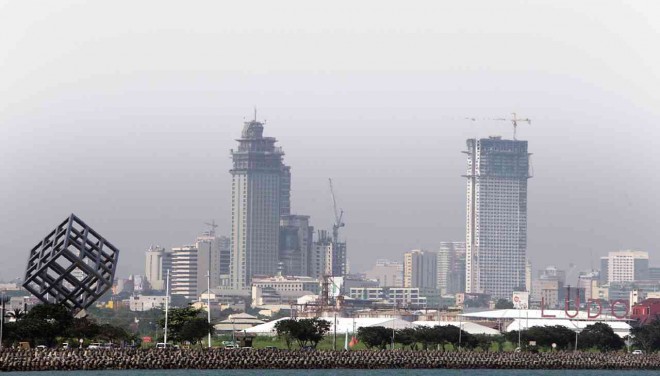
The Cebu City skyline is covered in haze that experts said reduced visibility from the usual 10 to 7 km in a phenomenon that neither environment nor weather bureau officials could explain in detail and with certainty. FILE PHOTO
The Inquirer is coming out today with the 19th in its series on pressing people’s concerns that should be high on the agenda of candidates for representative, governor or mayor in the May 9 elections. The series should help voters in the provinces choose their leaders wisely. In line with our “ThINQ. Vote.” advocacy, we have asked candidates in certain provinces, cities and congressional districts to outline their concrete plans of action in dealing with specific issues in their areas.
PROFILE: Cebu City
Known as “Queen City of the South,” Cebu City, more than 300 miles south of Manila, is the center of trade, commerce and education in the south.
Aside from a bustling economy and urban growth, Cebu is known for its culture and history. It hosts several historical sites, including Magellan’s Cross, Basilica Minore del Santo Niño and Fort San Pedro. Colon in the downtown area is the country’s oldest street.
Cebu hosts the Sinulog Festival every third Sunday of January that celebrates the feast of the Holy Child Jesus.
The city’s topography is unique: only 8 percent or 23 square kilometers is considered flatland, where half of the 80 barangays and the urban center are found.
The urban area hosts a profitable information technology-business process outsourcing industry. It ranked seventh in 2016 on the Tholons list of top outsourcing destinations.
The rest of Cebu, or 268 square kilometers, is mountainous or sloping.
Total population: 866,171 (as of 2010)
Voting population: 630,006 (as of April)
Land area: 291 square kilometers
Barangay: 80
Legislative districts: 2–north and south districts
(Sources: websites of the Cebu City Government, Comelec, World Bank, Department of Tourism and Philippine Statistics Authority; interviews with Comelec Cebu City)
CONCERN 1: TRAFFIC
Choked roads. Economic progress in Cebu City has enabled many residents to buy vehicles, with some families owning at least two cars each. The roads, however, need improvement. They are not wide enough to accommodate the increase in number of vehicles, thus causing traffic congestion. If elected mayor, how will you solve the worsening traffic problem?
Tomas Osmeña (Liberal Party)
- Pursue the recommendation of Japanese consultants to build 16 flyovers.
- Streamline the Bus Rapid Transit (BRT), which is my brainchild, and is patterned after Curitiba in Brazil.
- Upgrade the Building Code by requiring one parking slot for every 20 square meters on the ground floor and one parking slot for every 30 square meters on the second floor and above when constructing new buildings. If it is an old building, whatever has been approved before must be followed.
- When parking, motorists should not be allowed to back out onto the main road. Parking should be nose in, nose out.
Michael Rama (Incumbent, United Nationalist Alliance)
- Implement BRT.
- Remove road blocks, widen and open more roads.
- Get funding for the construction of subway and sophisticated traffic lights, as well as monorail.
- Continue holding seminars for drivers to remind them about traffic rules and regulations.
- No-nonsense implementation of traffic rules, provide incentives to traffic enforcers so they will not be tempted to receive money from motorists.
- Remove skywalks since people are not using them and they have become eyesores.
CONCERN 2: FLOODING
When it rains, it floods. While the city may now be suffering from the dry spell caused by El Niño, residents fear that when the rains come, so will the floods. Usually, it takes two hours of nonstop rain to inundate the city. How will you solve the flooding problem of the city?
Osmeña
- Push for P800-million drainage project, which aims to prevent the downward rapid rush of floodwater. Included in the project is the construction of retention ponds and mini ponds in the mountain.
- Build many silt traps to let water flow into the canals. They will also trap garbage so the canals will not be clogged. Maintenance crew can regularly remove the trash and clean the traps.
- Build a tunnel or two from Fuente Osmeña to redirect the flow of floodwater to the Guadalupe River.
- For the North Reclamation Area, build dikes and a wall up the Mahiga River to prevent overflow. Dikes can also be built in other rivers.
Rama
- What was initiated by Mega Cebu—the drainage master plan, which includes Cebu City— should be taken into account so we don’t do things ahead of the others.
- Put up a real drainage system, as well as a sewage treatment plant.
- Draw a comprehensive drainage plan.
- Implement river enhancement and restoration.
- Include the informal settlers along the riverbanks in the rehabilitation plan for the rivers.
CONCERN 3: FIREFIGHTING
Battling building fires. Skyscrapers dot the city landscape—another sign of its bustling economy. But the city’s fire department is not capable of putting out a fire that might break out in a high-rise building. What will you do to address this need?
Osmeña
- Twin towers are preferable for buildings over 10 stories high. The city should buy a 10-story fire ladder that costs over $1 million.
- Towers should be built far enough from each other to prevent the fire from spreading to the other building. But they should be close enough so it will not cost a lot to build footbridges connecting every floor of the two buildings from the 10th floor.
- Ensure that sprinklers of all buildings are operational.
Rama
- Decentralize and transfer control and maintenance of the Bureau of Fire Protection to the city government.
- Provide more fire trucks and uniforms and renovate the fire station.
- Civil society should help the city conduct regular inspections of buildings to ensure compliance with the Building Code.
- Amend the National Building Code, which is antiquated.